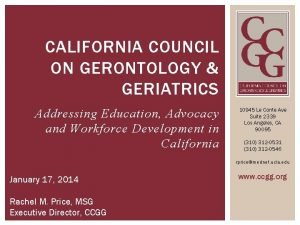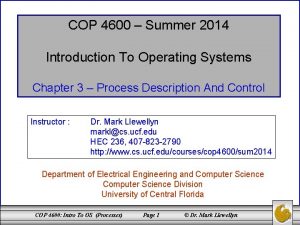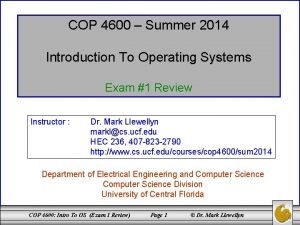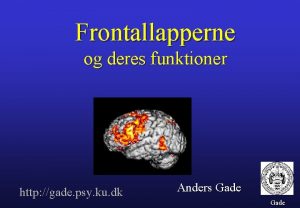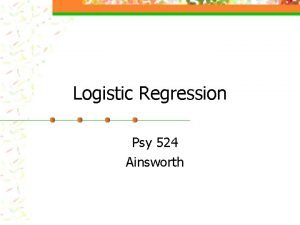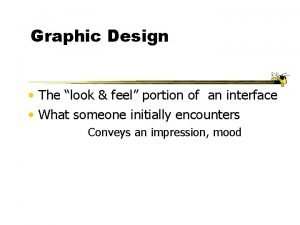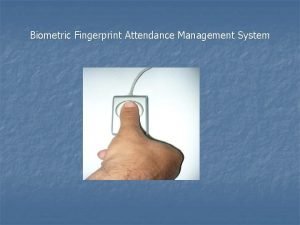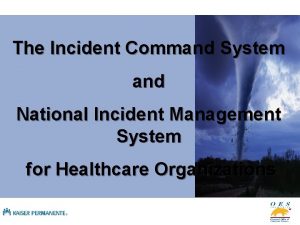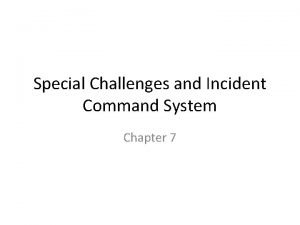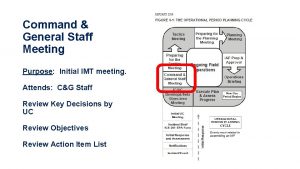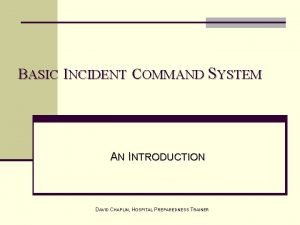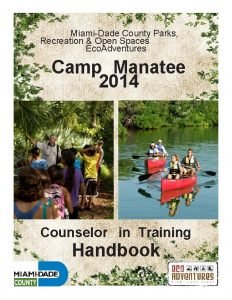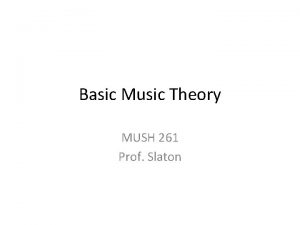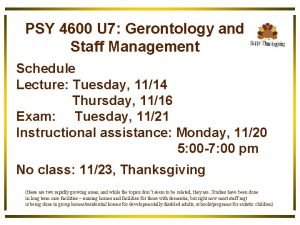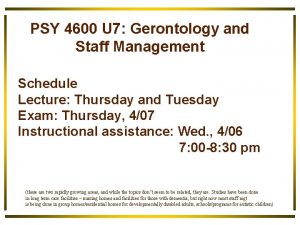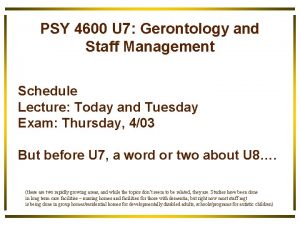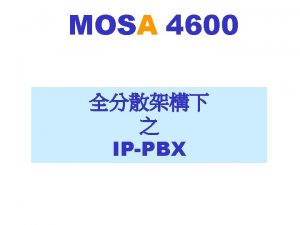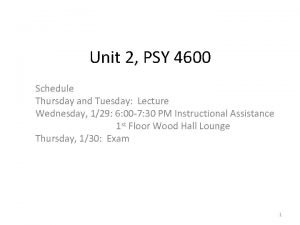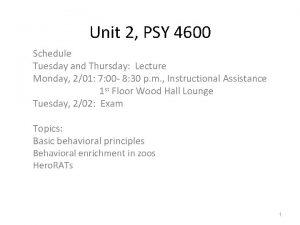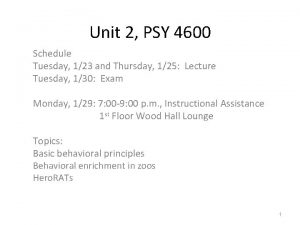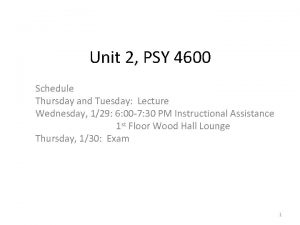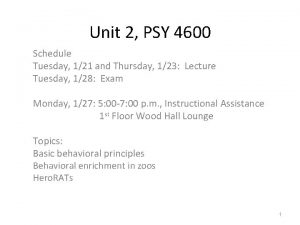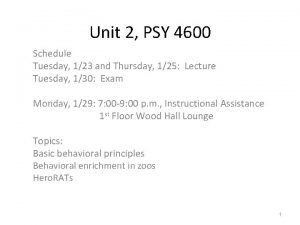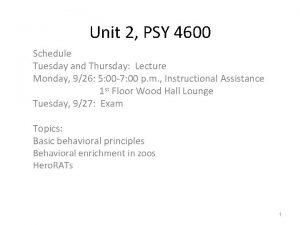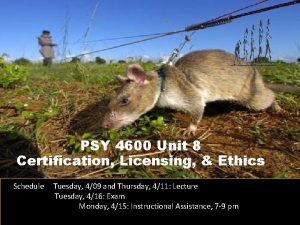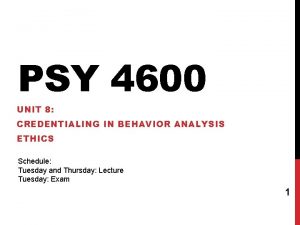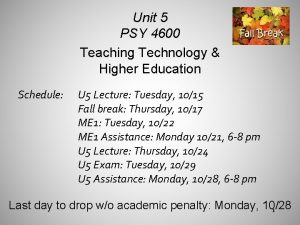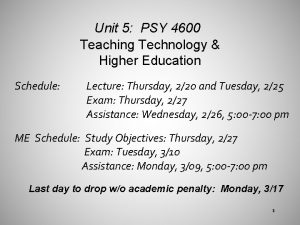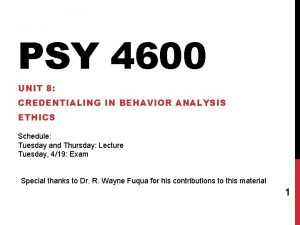PSY 4600 U 4 Gerontology and Staff Management





















































- Slides: 53

PSY 4600 U 4: Gerontology and Staff Management Schedule Tuesday, 2/11 and Thursday, 2/13: Lecture Tuesday, 2/18: Exam Monday, 2/17: Assistance, 5: 00 -7: 00 pm (these are two rapidly growing areas, and while the topics don’t seem to be related, they are. Studies have been done in long term care facilities – nursing homes and facilities for those with dementia; but right now most staff mgt is being done in group homes/residential homes for developmentally disabled adults, schools/programs for autistic children)

Gerontology • Behavioral gerontology is a growing field • There are not many Ph. D. level behavioral gerontologists in the world • Obviously, as the upcoming slides will point out we need more!

Gerontology: Expanded Services • More living options for seniors – In-home with assistance (daily living tasks) – Retirement communities with many different options and continuous care – Assisted living communities that specialize in dementia (these are not nursing homes or retirement communities) • WMU’s Center for Disability Services – Care management • Assessment and recommended options for care needs – Senior day programs – Supported living in-home, personal care – Respite care for caregivers

Gerontology: Expanded Services • Hospital-based medical in-home care • Commercial in-home service agencies • WMU’s Center for Gerontology at WMU – Minor in gerontology – Graduate certificate (fall 2015; 2019), 9 credits, online courses • Behavioral Gerontology SIG affiliated with ABAI: Great resource! – bgsig. wordpress. com • Provides publications in the area, 1975 -2019 • Provides recent presentations and posters • Provides a list of universities and professors providing training in this area • Provides employment and postdoc opportunities!

SO 1: Aging of America • The proportion of the population over age 65 in the U. S. increased from 4% to 13% in the 20 th Century • It is predicted to be 20% of the population by 2030 5

M. B. Smith, K. Gelles USA TODAY 6

SO 2: Aging of America, Contributing Factors • Medical advances increased life expectancy about 30 years between 1900 & 2000 • Aging of Baby Boomers • Born during the post-World War II baby boom • Years between 1946 and about 1964 – Cohort 1: 1946 -1955 – Cohort 2: 1956 -1964 7

SO 3: Effects of Aging Living longer means a substantial portion of elders live with chronic illness and disability – Higher total cost of care – Greater care needs – Potentially lower quality of life (more doctor’s visits, more medication, more MRIs, , more protthestics - hearing aids, walkers, etc. ) 8

Behavioral Gerontology • Application of behavioral principles to aging issues – Clinical/Rehabilitation Issues – OBM/Staff Training Issues • Different approach to aging from typical medical model of inevitable biological decline (Just because you lost it, doesn’t mean you can’t get it back; provide behavioral/environmental supports; teach people how to self-prompt) 9

SO 4: Behavioral Gerontology • From a behavioral perspective, when a person ages (examples of each follow) – Fewer discriminative stimuli control behavior – Different motivating operations are likely – Contingencies of reinforcement tend to support the wrong behaviors (Go back and look at examples of each) 10

SO 4: SDs become less effective • Get lost when driving to someplace you go to frequently (i. e. , the grocery store) and don’t know how to get home • Faces may no longer evoke correct names - even of loved ones • Trouble with ordinary conversations; words don’t evoke typical responses, particularly with a quick change of topics • Can’t write a check anymore, and certainly cannot master web banking (how do you pay bills? ) • TV/DVD/TIVO remotes (OK, this is ancient history to you, but it remains an excellent example): two or more remotes, each one is different (stimulus control combined with punishment), can’t figure out how to do things • Changing technology – phones used to be easy; using menus and navi keys are 2 nd nature to you – not to seniors; too many buttons, too many options! 11

Stimulus Control & Punishment Great Call Jitterbug phone: Great for seniors! (buttons are all in different places, symbols v. words, not one but two navi pads, jitterbugs) 12

SO 4: Different MOs • Deprivation of social contacts makes elders susceptible to telephone solicitors and scams by strangers (someone calls – they end up buying the product; someone comes to the door - they let them in) • Foot pain, hip replacement, arthritic pain make a decrease in pain reinforcing and evoke behaviors that lead to decreased pain – inactivity, watching TV, etc. win out over activities such as gardening, walking in the woods, needlepoint (also pain punishes those behaviors if engaged in) • Sleep deprivation is often present so evokes more irritable behaviors (when cut off when driving, or a relative is late for a visit, or a grandchild begins to cry/scream) Fact that not only quantity but quality of sleep changes with age 13

SO 4: Reinforcement for dependent behaviors and punishment for active behavior • When do you go see Grandma? When she is not feeling well. (reinforcement for complaining and behaviors related to not feeling well) • Punishment for verbal behavior when can’t “find the right word” or “follow the conversation” • “Does it hurt to do that? Why don’t you rest and let me do it? ” (reinforcement for dependent behaviors) • “Let me go to the grocery store for you” (same issue as with Fordyce, chronic pain) 14

Behavioral Gerontology • Use of behavioral procedures to solve problems related to SDs, MOs, and wrong reinforcement/punishment contingencies – No different than the approach we take in other areas of specialization 15

Enjoy Old Age, 1983 (click, animation) 16

SO 5: Why behavioral gerontology is needed • Behavior problems, not health declines or medical problems, are – Major cause of caregiver stress – The most common cause of institutionalization • I “can’t take it anymore” on the part of the caregiver – aggression, arguing, losing things, wandering, incontinence • 65% of individuals in nursing homes have significant behavior problems • Can lead to high staff turnover 17

NFE: Obstacles to widespread behavioral services • Practitioners are reluctant to serve elders – no training – Because of that it is hard to locate behavioral services • Older people and caregivers perceive stigma for accessing mental health services – Older adult: means “I’m crazy” – Caregiver: “a good son/daughter/wife/husband” could handle it without help (Cont. on next slide) 18

Obstacles, cont. • Medical Model Myths – Medications/drugs are the only thing that will work most common intervention – Once a skill is lost it cannot be regained • Cost and effort constraints – Simple and/or cheap will always be selected Which is simpler and less effortful? Medication or behavioral interventions? Elders are taking an average of 5 different meds 19

Bert • Levsin/SL Tablet Sublingual 0. 125 MG (Hyoscyamine Sulfate) – PRN every 6 hours • Clotrimazole Cream 1% – Twice daily • – Twice a day • • Clonidine HCL Tablet 0. 1 MG – Two times a day • Clonazepam Tablet 0. 5 MG – Twice a day Senexon-S Tablet 8. 6 -50 MG (Sennosides-Docusate Sodium) – 2 tablets • • Ammonium Lactate Cream 12% – Twice daily Trazodone HCL Tablet 150 MG Duloxetine HCL Capsule Delayed Release Particles 60 MG – Once a day • Levothroid Tablet 25 MCG (Levothyroxine Sodium) – Once a day • Levothyroxine Sodium Tablet 50 MCG – Once a day

SO 6: Anxiety and Depression • Anxiety and depression are not common in seniors, contrary to popular belief • Anxiety: – Only about 6% of healthy elders have clinical anxiety – Higher rates in elders with medical conditions • Depression – Only occurs in 2 - 10% of older adults – 2 x more in women (as in younger population) – 40 -50% of people in nursing/retirement homes • Which comes first, the chicken or the egg? 21

Behaviorally. . why depression/anxiety? – Loss of reinforcers due to changes in the environment • Including deaths of siblings, friends, and perhaps life mate – Loss of reinforcers due to physical deterioration of receptors • can’t hear or see as well • aren’t as strong • have trouble opening containers – Increased dependence but don’t want to be a burden • can’t drive anymore (can’t go shopping when you want to) – But remember, healthy seniors are not depressed or anxious • Economically stable (hopefully) • Tend to become more “forgiving” and “kinder” • Not as concerned about what other people think 22

Behavioral Gerontology Services • Typical Nursing Home – No active engagement, even in leisure activities – No social interaction or conversations – Memory problems – High rates of problem behavior Behavioral gerontologists have tackled each of these problems successfully 23

SO 7: Aggression • 85% of seniors with dementia physically aggress their care providers – This is one of the most common behavioral problems that leads to placement in long-term care facilities, physical constraints, and/or medication • 75% of the aggressive behaviors have been shown to be escape behaviors from antecedent task demands (MOs) related to daily living activities – Dressing, taking the senior to the bathroom, showering/bathing, brushing teeth, shaving, etc. (moderate to severe) – Antecedent MOs include verbal prompts, physical prompts, task demands: it’s time to get up, you need a bath/shower, put on your out-door clothes, why don’t you take a walk, you shouldn’t be drinking that glass of wine (mild to moderate) • NAG, NAG all day long! 24

SO 7: Aggression • Common behavioral interventions: – Care provider moves away and stops the demands • Often done to prevent the senior from “being too upset” • Care provider doesn’t want to be hurt – Care provider will skip doing care tasks What’s wrong with these interventions? ? (answer, next slide) 25

SO 7: Aggression What’s wrong with these interventions? ? MO: R Task demands, prompts Aggression Sr. No task demands In words: These interventions terminate the task demands, which negatively reinforces the aggression (This is why functional assessment, determining the cause of the behavior is so important before designing an intervention ) 26

SO 7: NFE What to do instead? • Extinction? No. • Takes multiple episodes of nonreinforcement of aggression and a long time for the aggression to decrease (during which aggression continues) • During that time both the elder and care givers are at high risk for being injured • Literature suggests that alternatives have been • High doses of medication • Strong verbal reprimands (punishment) • Physical restraints (clearly, these are not good alternatives – common) 27

SO 7: NFE, What to do instead? • Noncontingent escape – Determine interresponse time of aggression • Seconds before onset, seconds in-between – Provide escape (terminate the activity or prompt) before aggression occurs • Form of differential reinforcement Example: Elder in a nursing home aggressed against care givers during toileting. Found it was escape-maintained. It started ~30 s after toileting began, and thereafter every 25 s. Care givers prompted toileting, but stopped after 20 s, paused for 10 s, then began prompts again. Repeated this until end of toileting. Aggression decreased to near 0 levels. 26

The Intersection of Gerontology and OBM/Staff Mgt • It’s important for behavior analysts to develop and experimentally evaluate interventions to deal with problem behaviors • However, we need care givers and staff to implement those interventions • This is where OBM/Staff Mgt comes in (OBM in business and industry, but typically staff mgt in human services) 29

Gerontology and OBM/Staff Mgt • Direct care staff in nursing homes – Are CNAs (Certified Nursing Assistants) – Often receive low pay and work long hours – Have many potentially unpleasant aspects to their job – Are often kind people who sincerely want to help – Often have no idea that their actions are directly contributing to an environment that • Suppresses independence and activity • Reinforces problem behavior (note medical model, nursing, rather than hiring direct care staff with behavioral background – different than in group homes and residential facilities for children with IDD and/or autism, supervisors have a psychology/behavioral background) 30

Gerontology and Staff Mgt • Staff training and performance monitoring are a critical part of providing good care in nursing home settings • Staff will often acquire knowledge of procedures in in-service then fail to use the procedures when they interact with clients – No system in place to make it worthwhile or feasible to maintain new procedures 31

Engelman, Altus & Mathews (1999), Increasing Leisure Activities • Designed to increase engagement in leisure activities • Engagement in leisure activities is believed to: – Increase the quality of life of individuals by bringing them into contact with reinforcers they enjoy – Decrease inappropriate behaviors • Often, however, elders with dementia don’t initiate activities without assistance • While staff are encouraged to facilitate this, they are not trained to help them choose or maintain leisure activities • Furthermore, staff have a lot to do and may have many competing job responsibilities (Basically, just make them happier; True of other at-risk populations as well, IDD) 32

Engelman, Altus & Mathews (1999) • 5 residents in a nursing home with dementia • Intervention: – CNAs were trained to • Check-in with each of their assigned residents every 15 min • If engaged, praise activity • If not engaged, offer activity choices and assist if necessary – CNAs were observed and given written performance feedback • Measured appropriate engagement, inappropriate engagement, no engagement of residents • Research Design = MB across morning/afternoon (really cool design) 33

34

35

36

Engelman, Altus & Mathews (1999) • Results – All participants experienced increased appropriate engagement • over 80% of intervals in morning • over 70% of intervals in afternoon – MB design clearly shows the increase was due to the check-in procedure – Greater diversity of activities • 7 in baseline, over 20 in intervention (Piano player; sometimes the problem is they just can’t get started by themselves) 43

SOs 10 -16: Baker et al. , intro • Functional assessment and advances in Behavioral Gerontology 38

SO 10 B Functional Behavioral Assessment • A systematic method of assessment for obtaining information about the causes (functions) of a problem behavior • Results are used to guide the design of an intervention for – Decreasing the problem behavior and – Increasing appropriate behavior 39

Types of consequences that have been shown to maintain behavior • • • Social Positive Reinforcement (Attention) Social Positive Reinforcement (Tangible) Automatic Positive Reinforcement Social Negative Reinforcement (Escape) Automatic Negative Reinforcement 40

SO 11. Indirect/informant functional assessment • Structured interviews, checklists, rating scales, or questionnaires used to obtain information from people who are familiar with the person exhibiting the problem behavior – Used to identify conditions or events in the natural environment that correlate with the problem behavior – No manipulation of the environment 41

SO 11: Descriptive functional assessment • Direct observation of problem behavior and the antecedents and consequent events under naturally occurring conditions – No manipulation of the environment – Forms hypotheses of the possible function/s 42

SO 11: Functional analysis • An experimental analysis of the causes (functions) of problem behavior – Antecedents and Consequences representing those in the person’s natural routines are arranged – Within an experimental design so that their separate effects on problem behavior – Can be observed and measured to identify the maintaining function. 43

Order of progress for a functional assessment • Gather information via indirect and descriptive assessments • Interpret information from indirect and descriptive assessments and formulate hypotheses about the purpose of the problem behavior • Test hypotheses using a functional analysis. 44

Baker et al. (2011), intro A few facts about hoarding • Prevalence: estimates vary widely from study to study because it tends to be a “covert” behavior – 1%-22% of elders with dementia engage in hoarding • Traditionally, considered a low-severity behavior • What could go wrong, right? – Stress for caregivers – Distress for the person taking the item (especially when the item is taken back) – Aggression from those whose items are taken – Health risks (depending on what is taken) – Social isolation due to efforts to reduce hoarding 45

Baker et al. (2011), intro A few facts about hoarding • Typical recommendations for hoarding – – Increased monitoring by staff/caregiver Restrict access to items taken “Searches” for items already taken Medication • Medical interventions for hoarding – Pharmacological interventions (e. g. , SSRI – assumed to be part of an obsession and compulsion) – “no specific treatment outcome studies document the effects of the drugs for hoarding in individuals with dementia” 46

Baker et al. Summary • Participant – Margery, 80 -year-old woman with Alzheimer’s disease • Descriptive functional assessment to determine what was reinforcing wandering – Could not do a functional analysis – hoarding was low frequency and generally covert • Reinforcer Assessment – If hoarding is occurring, an operant account would suggest that there is something reinforcing the behavior – Hypothesis-based reinforcer assessments can inform intervention (not quite a functional analysis. . . ) – Question: Why take things? 47

SO 14: The three different conditions • We came up with three broad catetories that might touch on some reasons a person would hoard – Clean: clutter-free environment, no engagement with items, no prolonged access to items – Sort: clutter-free environment, engage with items, no prolonged access to items, – Storage: clutter-free environment, engage with items, prolonged access to items • Results of the assessment? – Reliably selected “sort” (not what we expected!) • Intervention – (reasons/hypotheses bold face and underlined) 48

SO 15: Item Removal and Redirection • After the descriptive assessment, baseline and reinforcer assessment were completed, staff developed and implemented an intervention for times when the behavioral support staff weren’t available. • Item Removal and Redirection (IRR)

SO 15: Item Removal and Redirection Description • Placed Margery at a separate table that did not have any craft or other items • If Margery got up to approach an item, the staff positioned themselves between Margery and the item, removed the item, or redirected her back to the separate table • Asker her to leave the item alone • Implications (these are NFE) – Even if Margery wanted to engage in an item or activity appropriately, she was blocked from doing so – Isolated from the rest of the residents – Thus, one purpose of the study was to develop a less restrictive, assessment-based intervention (redirection is one of the few recommendations, but staff intensive, and continuous interaction with staff)

SO 15: Compare the sorting activity to IRR Clinical implications* • Margery could now spend time with other individuals • Intervention took less time and was less effortful to IRR • Margery actually selected the intervention • Not only was item access not restricted, she was given prolonged access (quality of life) • Staff implemented the plan LONG after the thinning (we’re talking more than a year of staff implementation!) *Modified SO 15 B: State any two, also slide 54, not 49. 51

Success of Intervention Maintenance • Staff implemented the plan LONG after the thinning (we’re talking more than a year of staff implementation!) 52

Interested in learning more? bgsig. wordpress. com Dr. Jon Baker - jonathan. c. baker@wmich. edu Sandra Wagner (CDS aging services) sandra. wagner@wmich. edu 53
 California council on gerontology and geriatrics
California council on gerontology and geriatrics 4600 million years ago
4600 million years ago Ul 4600
Ul 4600 Cop 4600
Cop 4600 4600/365
4600/365 Cop 4600
Cop 4600 Cop 4600 ucf
Cop 4600 ucf 4600 miles
4600 miles Euro psy
Euro psy Ucf psi chi
Ucf psi chi Psy 2055
Psy 2055 Psy 2055
Psy 2055 Psy 2055
Psy 2055 Psy
Psy Daniel sanin
Daniel sanin Psy
Psy Psy
Psy Psy
Psy Psy
Psy Psy 226
Psy 226 Maria took a drink from a container marked milk
Maria took a drink from a container marked milk Alla kulikova
Alla kulikova Psy ku
Psy ku Psy walsh
Psy walsh Najlepsi polovnicky pes
Najlepsi polovnicky pes Túlavé psy vzor
Túlavé psy vzor 11 psy
11 psy Regression psy
Regression psy Psy
Psy Psy 335 purdue
Psy 335 purdue Staff acquisition in project management
Staff acquisition in project management Staff management tips
Staff management tips Attendance management system project report
Attendance management system project report Nims
Nims Lesson 5 staff and support agencies
Lesson 5 staff and support agencies Ics command and general staff
Ics command and general staff General staff meeting
General staff meeting Ics command and general staff
Ics command and general staff The structure of congress lesson 1
The structure of congress lesson 1 Miami eco adventures
Miami eco adventures Human resource management by gary dessler
Human resource management by gary dessler Precipitating factors cpi
Precipitating factors cpi The bass and treble staffs connected by a brace
The bass and treble staffs connected by a brace Job description of disbursing officer
Job description of disbursing officer Staffdeals
Staffdeals Top management middle management first line management
Top management middle management first line management Top management middle management first line management
Top management middle management first line management Middle level management
Middle level management Cmsd staff
Cmsd staff Keswick high school
Keswick high school Elms school
Elms school Cern staff association
Cern staff association Fhsaa lightning policy
Fhsaa lightning policy Booth staff training
Booth staff training
